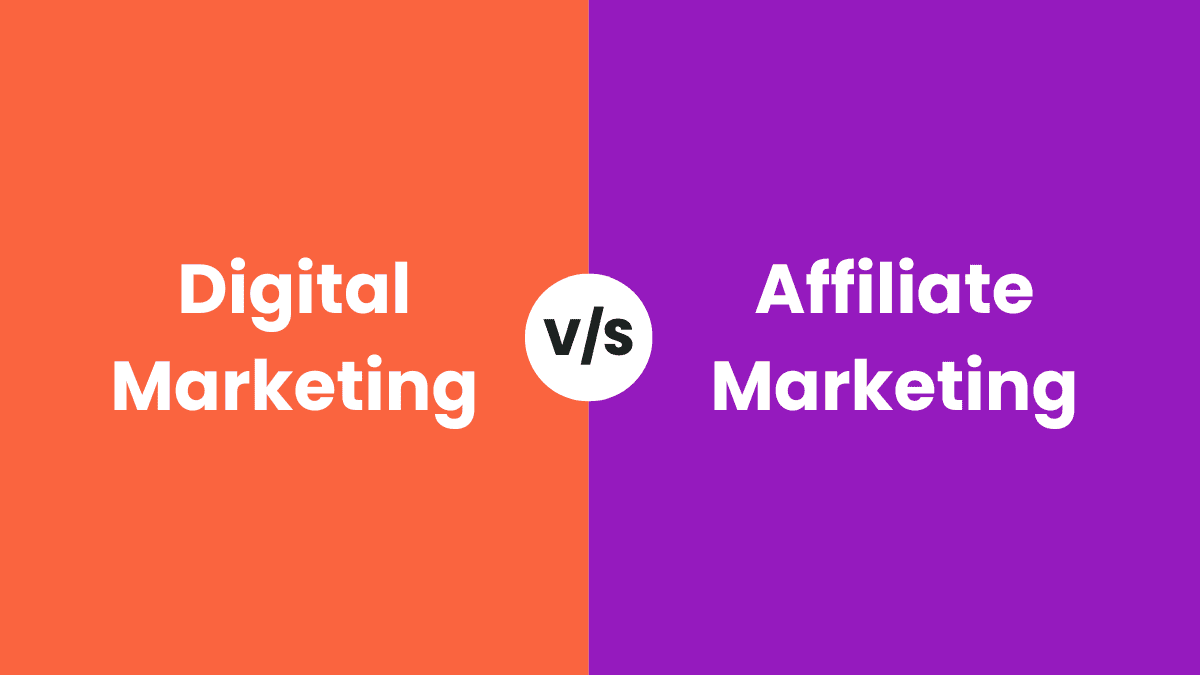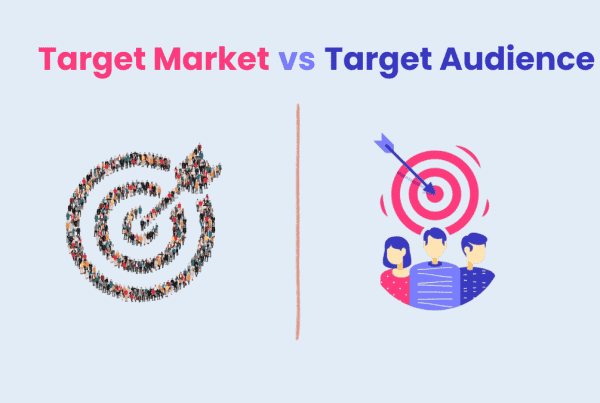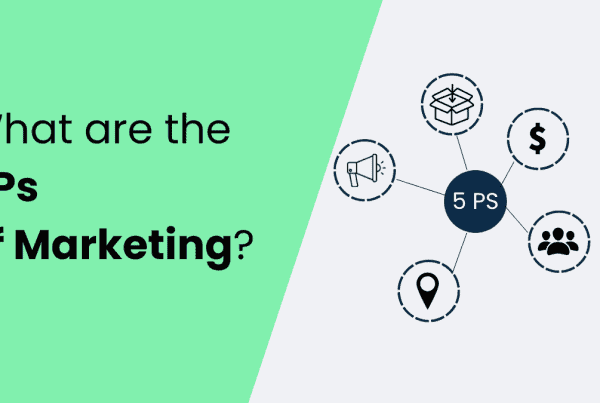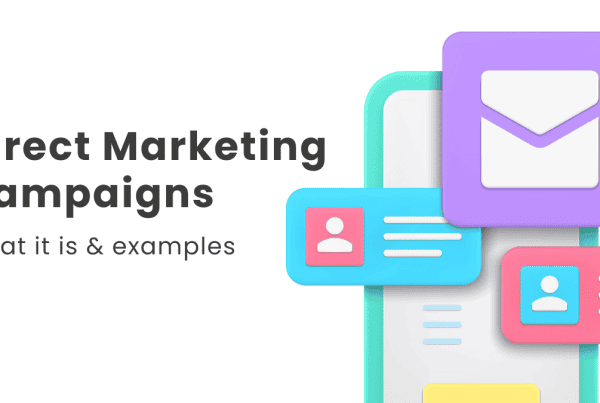
Digital marketing and affiliate marketing are two powerful strategies that can help grow an online business. But how are they different, and which one is the right fit for your goals?
Digital marketing covers all tactics for promoting products or services through digital channels, while affiliate marketing focuses on rewarding others for promoting your products. Both can boost revenue, but each has unique strengths.
In this article, we’ll break down the core concepts, differences, and connections between these strategies, helping you make an informed choice for your business. Let’s dive in!
Digital Marketing vs Affiliate Marketing: Fundamental Distinctions
Take a look at the table below for a simple comparison of how digital marketing and affiliate marketing differ.
| Aspect | Digital Marketing | Affiliate Marketing |
| Definition | Promotes products/services through online channels. | Pays commissions for others promoting products. |
| Scope | Includes SEO, social media, email, ads, and more. | A subset of digital marketing. |
| Focus | Builds brand awareness and drives direct sales. | Focuses on third-party promotion for sales. |
| Control | Fully controlled by the business. | Relies on affiliates to promote products. |
| Cost Structure | Includes ad spend, tools, and resource costs. | Primarily commission-based payments. |
| Best For | Businesses seeking direct control over marketing efforts. | Those aiming to leverage external promoters. |
What is Digital Marketing?
Digital marketing is the use of digital platforms and channels to connect with potential customers and promote products or services. According to Hostinger, Websites, social media platforms, and emails are the most used digital marketing channels for showcasing offerings, engaging audiences, and delivering updates.
Digital marketing helps businesses reach a wider audience, target specific demographics, and track results easily. It includes two main approaches:
- Organic Marketing: Focuses on growing traffic naturally through valuable content, SEO, and engagement.
- Paid Marketing: Involves spending money on ads or promotions to quickly reach a targeted audience.
By combining these strategies, businesses can build brand awareness, drive sales, and achieve significant growth.
Components of Digital Marketing
Here are the components of digital marketing:
Search Engine Optimization (SEO)
SEO refers to optimizing your website and its content to appear higher in search engine results. The goal is to drive organic (non-paid) traffic to your site. SEO involves keyword research, content optimization, improving website speed, and earning backlinks.
For example, a local bakery may optimize its website for keywords like “best cakes near me” to attract customers searching online.
According to HubSpot, 61% of marketers say improving SEO and growing their organic presence is their top inbound marketing priority. The benefit of SEO is that it increases visibility without direct cost, driving traffic that converts into long-term customers.
Content Marketing
Content marketing involves creating and sharing valuable content to attract and engage your target audience. This content can be blogs, videos, podcasts, or social media posts. A fitness brand might create workout videos or healthy living blogs to provide value while subtly promoting their products.
According to Hubspot’s state of marketing report, 82% of marketers are actively investing in content marketing. This strategy builds trust with your audience, enhances brand awareness, and can significantly improve conversions over time.
Social Media Marketing
According to Twicsy, 4.76 billion people use social media worldwide, and 73% of marketers believe it has been effective for their business.
This component focuses on promoting your products or services via social media platforms like Facebook, Instagram, Twitter, and LinkedIn.
A restaurant might run Instagram ads showing off their latest dishes or offer exclusive discounts to their followers. Social media marketing not only increases visibility but also fosters community engagement.
It helps to build direct relationships with customers, offering instant feedback and customer service.
Pay-Per-Click (PPC) Advertising
PPC advertising is a paid strategy where you pay each time someone clicks on your ad. Google Ads and Facebook Ads are popular PPC platforms.
For example, a startup selling eco-friendly products may use Google Ads to target keywords like “sustainable products” or “eco-friendly gifts.”
According to DemandSage, businesses make an average of $2 in revenue for every $1 spent on Google Ads. PPC offers instant visibility and measurable results, making it ideal for businesses looking for quick growth.
Email Marketing
Luisa Zhou states that for every $1 spent on email marketing, businesses earn an average return of $42.
Email marketing involves sending targeted messages to a list of subscribers. A brand may send personalized offers or updates to loyal customers to encourage repeat purchases.
For instance, an e-commerce store could email customers about a limited-time sale. This method allows for direct, personalized communication and is one of the most cost-effective ways to nurture relationships and encourage repeat sales.
Affiliate Marketing
Affiliate marketing involves partnering with individuals or other companies (affiliates) to promote your products, and paying them a commission for each sale they generate. For example, a blogger might share links to a company’s products and earn a commission for each product sold through their link.
According to the Authority Hacker, 81% of brands use affiliate marketing to acquire customers. It’s an effective way to leverage the reach of others while only paying for results.
Influencer Marketing
Influencer marketing taps into the reach of individuals with large followings on social media or other platforms. A beauty brand might collaborate with an influencer to promote a new product in exchange for payment or free products.
A study by Mediakix study found that 89% of marketers believe the ROI from influencer marketing is comparable to or better than other channels. This strategy can quickly expand brand awareness by leveraging the trust and credibility built by influencers with their audience.
Online Public Relations (PR)
A recent Global Trust in Advertising report by Nielsen, which surveyed over 28,000 online participants from 56 countries, found that 92% of people worldwide trust earned media-like recommendations from friends and family more than any other type of advertising. This trust has grown by 18% since 2007.
Online PR involves managing your brand’s reputation and establishing positive relationships with online audiences. This can include engaging with online reviews, responding to customer feedback, and participating in relevant online communities. Effective online PR builds trust and enhances your company’s reputation.
Video Marketing
Video marketing involves creating and sharing videos to promote your products, services, or brand. Platforms like YouTube, Instagram, and TikTok are used to reach audiences with entertaining or educational content. A tech company might create a tutorial video to showcase how their product works.
According to Wyzowl, 86% of businesses use video as a marketing tool, and 93% of marketers say video has increased customer understanding of their product or service. Videos engage customers effectively and are shareable, providing long-term exposure.
Mobile Marketing
Mobile marketing targets users on their smartphones through apps, SMS, mobile websites, and push notifications. A retail brand may send promotional SMS messages about discounts or new arrivals.
Bank My Cell states that 6.92 billion people worldwide own a mobile phone, making it a key channel for digital marketing. Mobile marketing ensures you’re reaching your audience where they spend most of their time, delivering messages in real-time and increasing conversions.
These components play a vital role in building a robust digital marketing strategy. They allow businesses to engage with their audiences in multiple ways and at various stages of the buying journey.
By understanding and leveraging these components, businesses can enhance their online presence, generate leads, and improve conversion rates.
What is Affiliate Marketing?
![[your-subject] - EyeUniversal Affiliate Marketing](https://www.eyeuniversal.com/wp-content/uploads/2024/12/Affiliate-Marketing.png)
Source
Affiliate marketing is a performance-based marketing strategy in which individuals or businesses (merchants), called affiliates, earn commissions by promoting the products or services of another company.
Affiliates use platforms like blogs, websites, social media, or email to share unique affiliate links. The affiliate earns a commission when customers click on these links and make a purchase.
![[your-subject] - EyeUniversal Affiliate Marketing Programs](https://www.eyeuniversal.com/wp-content/uploads/2024/12/affiliate-marketing-programs.png)
Affiliate marketing thrives on collaboration, making it a win-win strategy for all involved. With nearly 80% of brands running affiliate programs and its ability to generate substantial online sales, affiliate marketing continues to grow as a vital part of digital strategies
This model is popular because it’s cost-effective, measurable, and allows businesses to tap into diverse audiences through trusted promoters.
Components of Affiliate Marketing
Affiliate marketing is built around several key components, each playing a vital role in the ecosystem. Here’s an overview of these components:
Advertisers (Merchants or Brands)
Who are advertisers? Advertisers are businesses or individuals that offer products or services and want to expand their market reach through affiliates. For example, a fashion retailer launches an affiliate program to promote its seasonal collection through influencers and bloggers.
Advertisers can achieve cost-effective marketing, by paying only for measurable results like clicks or sales. Ecommerce Platforms’ statistics show that affiliate marketing accounts for approximately 16% of all online orders, making it a reliable method for driving revenue.
Affiliates (Publishers)
Who are affiliates? Affiliates are individuals or entities that promote the advertiser’s products to earn commissions. They can use blogs, social media, or other platforms for promotions.
An example of an affiliate could be a tech blogger joining an affiliate program to promote gadgets by writing reviews and embedding affiliate links.
Affiliates can earn passive income without the need to handle inventory or customer support. According to PayScale, affiliate marketers can earn an average of $53,000 per year..
Affiliate Networks
Affiliate networks act as intermediaries between advertisers and affiliates, providing tools for tracking, payments, and program management. These networks simplify the process for advertisers and affiliates, offering transparency and streamlined operations. They help scale campaigns effectively while reducing administrative overhead. Examples of affiliate networks are ShareAsale, CJAffiliate, Awin, etc.
Customers
Customers are the end-users who purchase products through affiliate links. Their preferences and behaviors significantly influence affiliate success. Customers benefit from personalized recommendations and trustworthy reviews, improving their shopping experience.
Supporting Tools and Services
These include tracking software, analytics platforms, and content management tools that optimize affiliate campaigns. Tools enhance efficiency and data-driven decision-making, enabling affiliates and advertisers to maximize ROI. For example, detailed analytics can reveal high-performing affiliates and effective campaigns..
Affiliate marketing benefits everyone, Merchants gain more sales without upfront marketing costs, Affiliates earn by promoting products to their audience, and Customers often enjoy deals or discounts without paying extra.
Wrapping it up…
Digital marketing and affiliate marketing are both effective ways to grow a business online. Digital marketing includes various strategies that help businesses connect directly with their audience and build their brand. Affiliate marketing focuses on performance, where affiliates earn commissions by promoting products, making it a low-risk and rewarding option for advertisers and creators.
In the future, both will grow with the help of AI and better tools, making campaigns more targeted and results-driven. Choosing one depends on your goals, but using both together can bring the best results for online success.
Frequently Asked Questions
Can small businesses use both digital and affiliate marketing?
Yes, small businesses can benefit from both. Digital marketing helps grow brand awareness, and affiliate marketing is affordable since you only pay for sales or results.
Which is cheaper: digital marketing or affiliate marketing?
Affiliate marketing is often cheaper because you only pay for results. Digital marketing can cost more but offers more control and a larger audience reach.
Can a business use digital marketing and affiliate marketing together?
Yes! Using both strategies together can help businesses reach more people, save costs, and get better results.
Is affiliate marketing better for individuals or companies?
Affiliate marketing is great for both. Individuals can earn money by promoting products, and businesses can increase sales without spending much upfront.
Which is better for long-term success: digital marketing or affiliate marketing?
Digital marketing helps build your brand and long-term customer relationships, while affiliate marketing is better for quick sales and short-term results.



